Telemedicine App Development: Complete Step by Step Guide
Ashok Sachdev
October 17, 2023 860 Views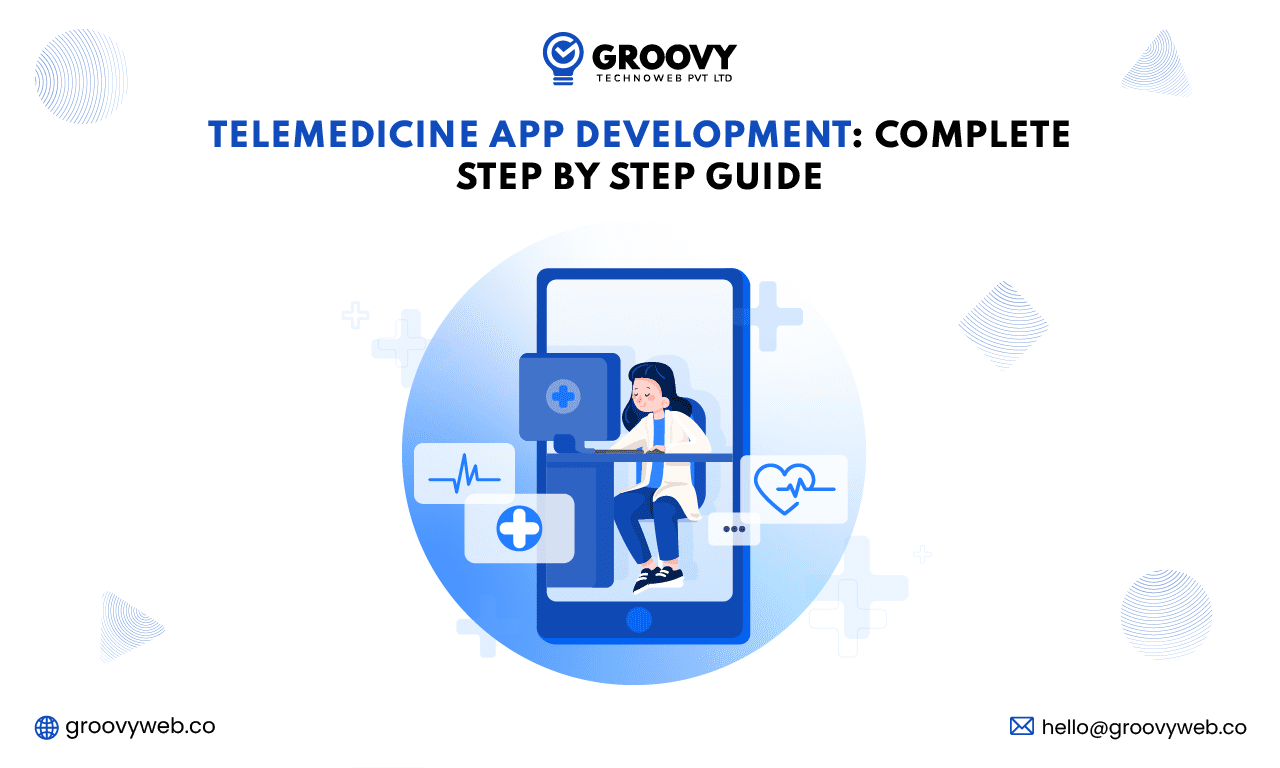
Quick Summary : Telemedicine app development involves creating apps for remote medical consultations. A complete guide includes market research, feature definition, platform selection, interface creation, security compliance, testing, and deployment. A dedicated team of developers, designers, and medical experts is essential for creating a successful telemedicine app.
The term “telemedicine” is no longer a catchphrase in the healthcare sector. Telemedicine was expanding even before the coronavirus crisis.
Let us look at the complete healthcare app development guide to have a clear understanding of the concept and helps to make a decision in developing your telemedicine app.
In 2023, the global telemedicine market is projected to reach USD 56738.3 Million at a CAGR of 16.8%.
The introduction of a telemedicine app couldd enhance the field and represent a groundbreaking service for many medical professionals. Telemedicine has the ability to ease the difficulties involved in providing healthcare and make access to medical institutions simple.
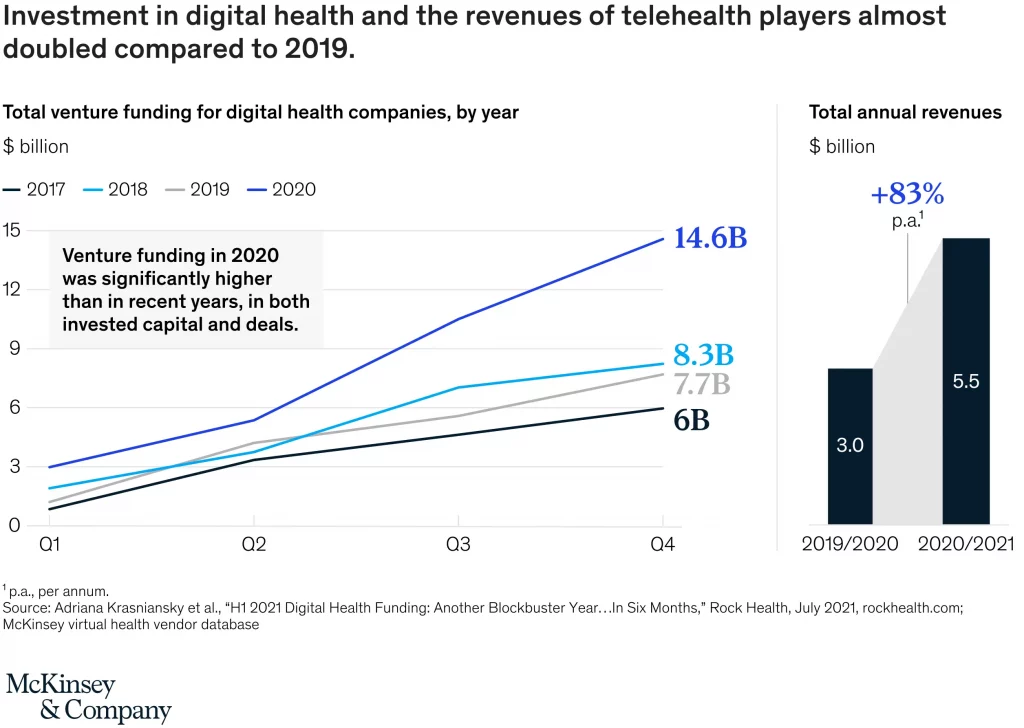
Source: McKinsey.com
Today, healthcare businesses of all sizes are quickly incorporating telehelath into their operations in order to stay on top of the constantly changing healthcare industry.
What is a Telemedicine?
Telemedicine refers to providing remote clinical services to patients without physical interactions. It is possible because technology enables patients and healthcare practitioners to communicate using telemedicine apps.
Telemedicine allows patients to communicate with healthcare professionals regarding their health issues, medical problems, and overall health through live video calls, web-based portals, etc. In addition, they can learn about diagnosis and treatment options as well as get prescriptions.
What is a Telehealth?
The use of telecommunications technology to deliver medical services remotely is referred to as telehealth, also known as telemedicine. It includes a broad variety of medical services such as consultations, diagnosis, treatment, monitoring, and education that are all carried out via various digital communication channels.
Telehealth can take many different forms, such as:
Through video conferencing, patients and medical professionals may communicate live and in-person through video. This is especially helpful for going through symptoms, getting advice from a doctor, or scheduling follow-up appointments.
Healthcare practitioners: may provide phone consultations, which can be more convenient for patients who may not have access to video-conferencing equipment.
Remote monitoring: Patients may check their blood pressure, heart rate, or blood sugar levels via linked equipment. Healthcare providers receive the data for ongoing monitoring.
Asynchronous communication: Patients can transmit messages or pictures of their symptoms to medical professionals, who will answer as soon as it is convenient. This is frequently used to non-urgent issues.
Online portals: Many healthcare organisations allow patient access to their medical records, appointment scheduling tools, and channels for online communication with their healthcare team.
Benefits of Telemedicine App Development
Given below are just some of the many benefits your doctors and other medical personnel will get from using a telemedicine app you create for your healthcare company.
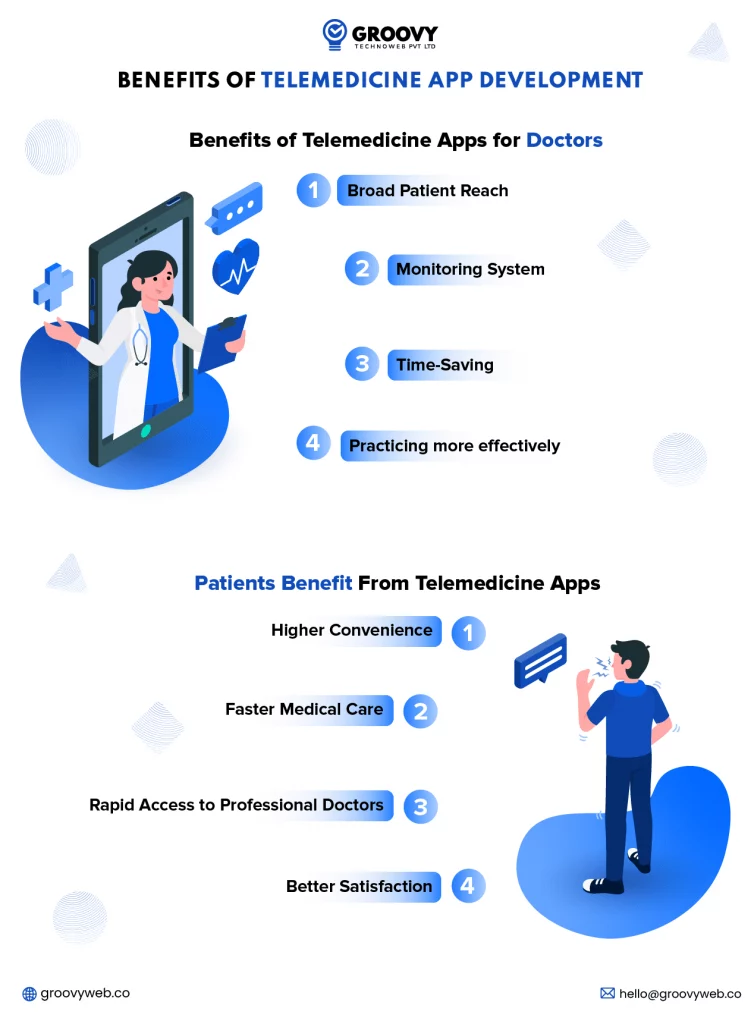
Benefits of Telemedicine Apps for Doctors
Broad Patient Reach
In general, professionals and doctors are only readily available in a nation. The telemedicine app makes it possible for doctors to access patients everywhere there is internet access and deliver medical care.
Monitoring System
Apps for Telemedicine provide reliable monitoring and management that archives all patient information and makes them available anywhere, at any time. Doctors, therefore, find it simpler to schedule follow-up consultations as a result.
Time-Saving
Doctors save a great deal of time by automating the fundamental process with the telemedicine app.
Practicing more effectively
The ability of telehealth apps to store every minute aspect about a patient dramatically enhances the doctor’s ability to make informed decisions. This means that, as a result, doctors can treat a greater number of patients since they no longer need to be physically present.
What Are The Advantages Of Telehealth For Patients?
Similar to doctors, patients gain a lot from using telemedicine apps. Telemedicine apps offer patients a number of advantages.
Higher Convenience
A telemedicine app’s primary goal is to simplify the patient’s experience as much as possible. Instead of traveling for a checkup, the individual can communicate with doctors online thanks to the telemedicine app.
Faster Medical Care
Patients with mild health conditions, such as a cough or fever, can use telemedicine apps to communicate with doctors and receive prescriptions through their smartphones, making them particularly helpful. Through telehealth you are no need to get an appointment to doctor.
Rapid access to professional doctors
In some of the cases, patients must travel long distances to get medical care from experts since they can’t find those specialists in the local city or region.
Such patients can contact any type of professional from their cellphones and receive assistance for any medical difficulties thanks to the telemedicine app.
Better Satisfaction
Telemedicine apps significantly improve patient experience since they enable healthier doctor-patient communication and give patients access to medical care around the clock.
Challenges Face in Telemedicine App Development.
After outlining some of the advantages of telehealth for patients and medical professionals, let’s have a look at some typical difficulties in creating a modern telemedicine app.
| Aspect | Description |
| Data Protection | Developers should use secure application development frameworks to safeguard patient information. |
| Regulatory Compliance | Organizations must comply with regulatory authorities to protect clients’ private and sensitive data. |
| Maintaining Video Quality | The app should consider patient equipment and internet access to guarantee that all app users receive high-resolution photographs and videos during real-time telemedicine sessions. |
| UI/UX Implementation | Developers should implement telemedicine software features that work across multiple devices and platforms, ensuring consistency for a better user experience. |
| Integrating the Back End | A good backend ensures seamless data flow between patient and doctor, including integrating third-party services in compliance with the law. Both sides of the app must agree on a set of protocols for this to work. |
| Scalability | The app should be able to handle many users during peak hours, and scale its system resources to accommodate growth. |
Data Protection
Healthcare providers ask telemedicine application developers the most crucial question about data protection. Patients are also curious about how the app would retain their private data and how safe it will be.Developers should utilize well-established application development frameworks with a highly secured layout to securely store, in order to safeguard patient information.
Regulatory compliance
In order to protect clients’ private and sensitive data, organizations must comply with the requirements of regulatory authorities. An example of laws that must consider while building a telemedicine app is the United States has HIPAA, Canada has the (PIPEDA), etc.
Groovy Web is an top-notch telemedicine software development company, if you want to comply with these global data security regulations. We have experience creating, building, and integrating mobile apps for healthcare providers across Europe and the United States according to international standards for data security.
Maintaining video quality
Patients must be able to receive care via video calls during real-time telemedicine sessions. Due to the variance in the type of patient equipment and internet access, this could be difficult. Therefore, it is crucial to consider these elements during the creation process to guarantee that all app users receive high-resolution photographs and videos.
UI/UX implementation
It is very important for the app to have a good user interface. Consequently, developers must implement telemedicine software features that work across multiple devices and platforms. Moreover, app developers must ensure that both ends of the app work together and that all aspects are consistent. In doing so, it enhances the user’s experience.
Integrating the back end
In an app with a good backend, both the patient’s and doctor’s data flow will be seamless. The procedure is far more complicated than it seems because it requires integrating third-party services, such as payment options and location services. Additionally, all of these must be in accordance with the law. For this process to be effective, both sides of the application need to agree on a set of protocols.
Scalability
Building a telemedicine app solution should have taken into account the number and growth of users. During peak hours, your app might not be able to handle many users if you don’t take this into account. To accommodate the increase, the app should also be able to scale its system resources.
Top 5 Trends in Telemedicine App Development
- Telemedicine software that is HIPAA, PIPEDA, MOHAP, and GDPR-compliant is a requirement.
- Multi-equipment integration and wearables integration for remote patient monitoring.
- The increasing demand for essential software functions like insurance and online pharmacy access.
- Focusing more attention on Telemedicine for newborns and other patients in need of ongoing care.
- Increasing demand for patient data protection, provider cooperation, and essential software capabilities, including real-time tracking.
Telemedicine app development guide step by step
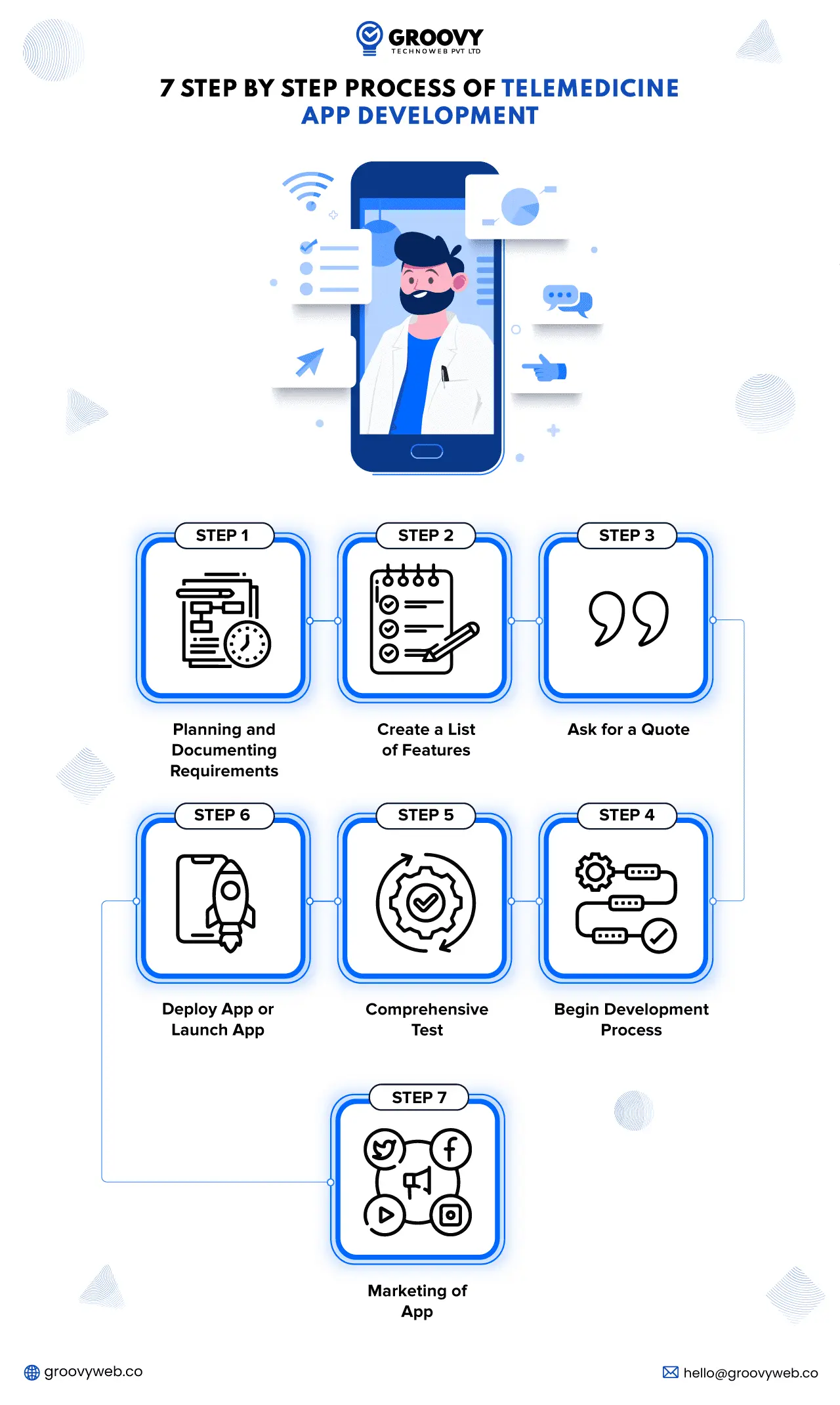
Step 1: Planning and documenting Telemedicine app requirements.
It is essential that you must document all of your criteria before starting to develop your Telemedicine software. During this phase, we analyze the market, identify our competitors, identify our target customers, and develop a concept for a product.
You need to develop a frame of the document library, outline your product roadmap, and explain how the telemedicine software would benefit patients and medical professionals based on the data you acquired during the research phase.
Step 2: Create a list of features for your telemedicine app
In the next step, you need to choose which functionality each user will require for your telehealth app.
There will probably be a specific list of capabilities required for your telehealth app.
In order to make this phase easier, we’ve included some of the most popular and essential features of telemedicine apps.
Feature List for Patients
| Feature | Description |
| Easy registration | Patients can register themselves easily by filling in necessary personal and health information. |
| Search option | Patients can search for nearby doctors based on their specialty and other filters. |
| Doctor profile | Patients can view the doctor’s profile and check details like ratings, customer feedback, check-up fees, and more. |
| Appointment Booking | Patients can book a slot for the doctor’s appointment based on their regular/urgent needs as per doctor availability. |
| Video Consultation | High resolution video chats to facilitate face-to-face consultations between patients and their doctors. |
| Instant Messaging | Patients can connect with doctors in real-time through instant messaging to get information about their well-being status. |
| Upload medical files | Patients can maintain quality without sacrificing security when storing and sharing medical files, photos, and patient history. |
| Payment options | Patients can pay the doctor’s consultation fees easily and quickly using different payment options like debit, credit cards, online banking, and more. |
Feature List for Doctors
| Feature | Description |
| Easy Login | Doctors can easily register and log in through mobile number and email verification in the app. |
| Appointment Management | Doctors can easily manage all the patient’s bookings, approve or reject, and view upcoming appointments. |
| Online Scheduling | A doctor can set their schedule in the calendar by inserting a date interval, the start and end time of a patient’s appointment. |
| Patients Details | Doctors can view patients’ health details, past medical data & history, the reason for the clinical visit. |
| Live Messaging | Doctors can communicate with the patients live to check their well-being status & prescribe medication at the same time. |
| Video Consultation | Safe & confidential WebRTC-based video tools for a high-definition video consultation with the patients. |
| EMR Integration | Sync patient data & histories with EMR for convenient remote consultations. |
| Multi-way Video | Allowing the patients and doctors to have multi-way video solutions and add their family members, friends, and others. |
Once features list is done then search for telemedicine app development company and ask for the quote
Step 3: Ask for a Quote
As soon as you’ve finalized the feature list, you should contact potential app development partners to get an approx. figure for the cost of developing telemedicine app.
You may always get in touch with us, a custom mobile app development firm with experience & an established track record in creating various sorts of telemedicine apps if you are still looking for prospects in mind.
Step 4: Begin Development
Once you have teamed up with an app development company for Telemedicine, it’s time to start developing the app. In most cases, backend development comes first, followed by user experience design, then wireframes and prototypes.
Step 5: Comprehensive Test
During the last stage of development, you should thoroughly test your telemedicine app to ensure it is functioning as it should.
Also, you should ensure that both doctors and patients are satisfied with your telehealth software’s user experience across various platforms.
Step 6: Deploy App or Launch App
Once the telemedicine app is finished, you must ensure that your telemedicine development company releases it in accordance with Google Play Store and iOS App Store conditions.
As soon as your app has been approved for the App Stores, do a trial run to verify everything works as it should and that you are satisfied with the results.
Step 7: Marketing of App
The final phase of the process is to launch your telehealth app in the market like a beta version. When your app is out, make sure to seek input from patients as well as physicians and make any necessary changes.
How much does telemedicine app development cost?
Again, this is dependent on the telemedicine app’s demands, objectives, and technical characteristics.
On the other hand, the cost to develop a custom telemedicine app is typically between $110,000 and $220,000. Despite this, it is possible to develop a minimum viable product (MVP) for a telemedicine app for under $50,000. Request an MVP price here by contacting us.
Conclusion
Creating a healthcare app is quite difficult and full of obstacles. Despite this, you can guarantee your app’s success if you consider the advice outlined above. These apps benefit consumers and developers, who make money from them.
If you have any further confusion, take help from a leading health care app development company like Groovy Web. It designed, developed, and deployed legally compliant mobile and online applications.
Our affordable and modern solutions and services have helped healthcare clients in the iOS & Android industries reach their business goals more quickly and succeed in a very competitive market. We can assist you in building an effective, reliable, and secure telemedicine app for your company.
Written by: Ashok Sachdev
Ashok Sachdev is the Project Manager at Groovy Web who began his professional career as a programmer at the young age of 17. Ever since then he is actively growing, learning new things, and adapting to new roles and responsibilities at every step. Aside from being an app developer, he is highly admired for his project management skills by his clients.
Frequently Asked Questions
We hope these clear your doubts, but if you still have any questions, then feel free to write us on hello@groovyweb.coWhat are the essential steps for developing a telemedicine app?
The essential steps for developing a telemedicine app include market research, defining features, choosing a development platform, creating a user-friendly interface, integrating essential features such as video conferencing and messaging, ensuring security compliance, testing, and deployment.
How can you ensure security compliance for a telemedicine app?
To ensure security compliance, it is important to follow regulatory requirements and seek legal advice, use secure data encryption and authentication methods, and implement strict access control measures.
What features are necessary for a telemedicine app?
Essential features for a telemedicine app include video conferencing, messaging, medical record management, payment integration, and appointment scheduling.
Related Blog

Rahul Motwani
SaaS Application Development Benefits, Cost, Features & Design Tips
Software Development 06 Feb 2023 15 min read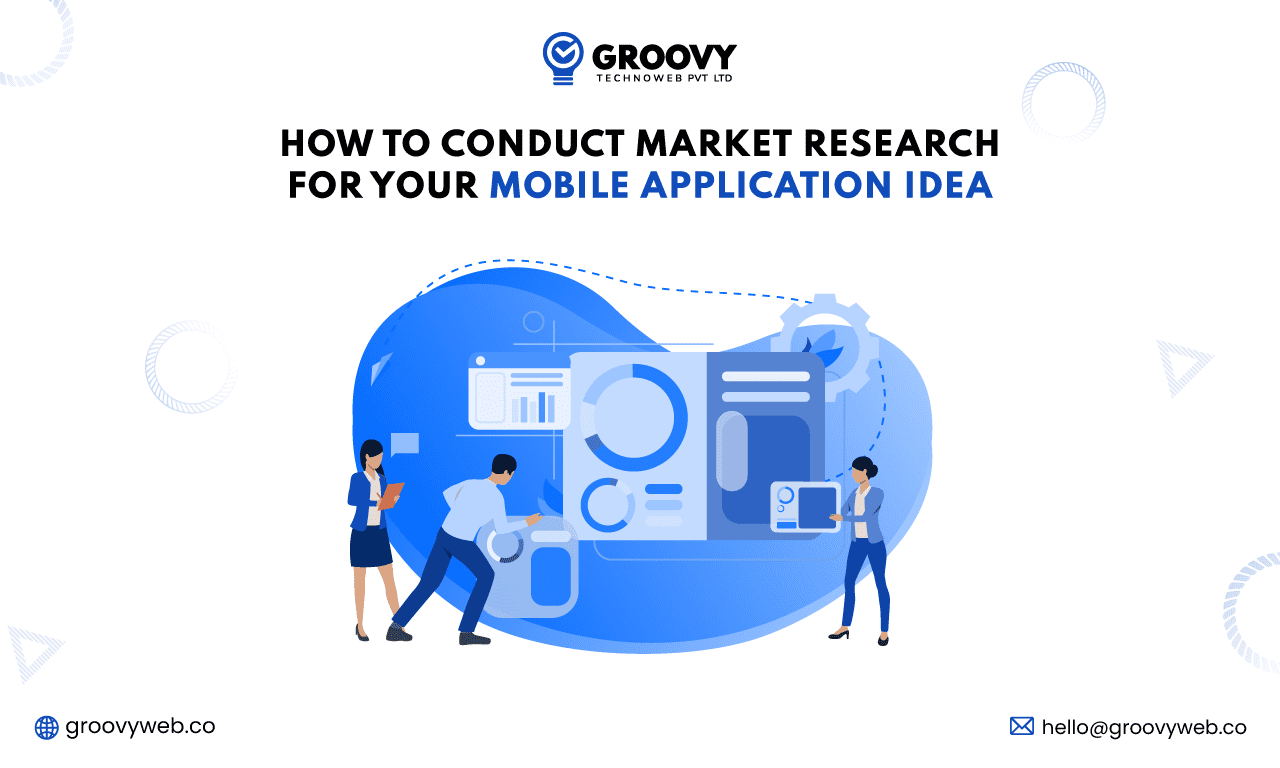
Rahul Motwani
How to Conduct Market Research for Your Mobile Application Idea
Mobile App Development 22 Feb 2023 12 min read
Rahul Motwani
How to Outsource Mobile App Development in 2023
Mobile App Development 26 May 2023 11 min readSign up for the free Newsletter
For exclusive strategies not found on the blog